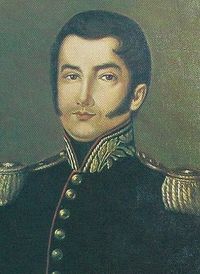José María Paz
The Cisplatine War (known in Brazil as the Guerra da Cisplatina) pitted the two countries against each other for the territories at that time called Provincia Oriental (nowadays Uruguay) and the Misiones Orientales, occupied by the Brazilians since their victory of the Battle of Tacuarembó over José Gervasio Artigas in 1820.After the end of the war with Brazil, Paz returned to Buenos Aires, where General Juan Lavalle headed the Decembrist revolution and ordered him to prepare the army to combat the many caudillos that were emerging in the provinces.In his writings, especially in Memorias, Paz tells about his astonishment to see farm owners fighting and declaring war against the central government, and the population supporting them.Paz decided to start his campaign against the caudillos in Córdoba Province with a small force (about 1000 men strong), many of them veterans who served under him in the Cisplatine War.The Federal Pact was signed in 1831 between the Provinces of Buenos Aires, Entre Ríos and Santa Fe, which joined to defeat the Unitarian League.He thus went on a reconnaissance mission to assess a good place to fight the caudillo, but the woods he was inspecting were not under the control of his forces but instead a small federal party of soldiers was patrolling it.Realizing that such a move would leave Corrientes undefended, Paz refused and decided to stay to help Governor Pedro Ferré organize the resistance to Echagüe.After several months of inconclusive skirmishing and guerrilla warfare, by November 1841 Paz reckoned his Escueleros were battle-hardened enough to give his enemy a nasty surprise.[3] In 1842 he invaded Entre Ríos, pursuing the battered remains of Echagüe's forces (who resigned his office as governor) and took La Bajada (present Paraná city), seizing the government in the province.Knowing that Rosas intended to annex Paraguay as a province of the Confederation, Paraguayan president Carlos Antonio López signed with Madariaga and Paz on November 11, 1845, a treaty (Tratado de Alianza y Convicción Adicional).In spite of Paz's visible position against the Buenos Aires Constituent Congress, he was elected member of the convention, which he did not attend regularly due to health problems.



José María Paz (footballer)Córdoba, ArgentinaBuenos AiresArgentine War of IndependenceCivil WarArgentineArgentine Civil WarscriollosUniversidad de CórdobaMay RevolutionRoyalistsUpper PeruArmy of the NorthManuel BelgranoBaron von HolmbergVilcapugioAyohumaJuan Martín de PueyrredónCoronelEstanislao LópezFederalCórdobaArequito RevoltJuan Bautista BustosAlejandro HerediaArequitoSantiago del EsteroCatamarca ProvinceSalta Provincewar against BrazilCisplatine WarUruguayMisiones OrientalesBattle of TacuarembóJosé Gervasio ArtigasBattle of ItuzaingópresidentBernardino RivadaviaJuan LavalleDecembrist revolutioncaudillosUnitariansFederalsCórdoba ProvinceBattle of San RoqueLa RiojaFacundo QuirogaUnitarian LeaguefederalistJuan Manuel de RosasFederal PactEntre RíosSanta FeLujánMontevideoPascual EchagüeParaná RiverPedro FerréBattle of CaaguazúGuaraní languageParanáManuel OribeJoaquín MadariagaParaguayprovinceCarlos Antonio LópezJusto José de UrquizaLaguna LimpiaUbajayRio de JaneiroSanta Fe ProvinceState of Buenos AiresDomingo SarmientopresidencyBuenos Aires ProvinceGeneral Paz AvenuecordobésEnglishArgentine Civil Wars (1814–76)FederalistsMariano VeraFrancisco RamírezManuel DorregoRicardo López JordánChacho PeñalozaCarlos María de AlvearJosé RondeauJuan Esteban PederneraGregorio Aráoz de LamadridDomingo Faustino SarmientoCepeda (1820)San Roque (1829)Márquez Bridge (1829)Famaillá (1841)Caaguazú (1841)Laguna Limpia (1846)Caseros (1852)Cepeda (1859)Pavón (1861)Pilar (1820)Benegas (1820)Quadrilateral (1822)Cañuelas Pact (1829)Federal Pact (1831)San Nicolás (1852)Pact of San José de Flores (1859)United Provinces of the Río de la PlataLeague of the Free PeoplesRevolution of the RestorersArgentine ConfederationUruguayan Civil WarFreemen of the SouthRevolution of 11 September 1852Argentine Constitution of 1853